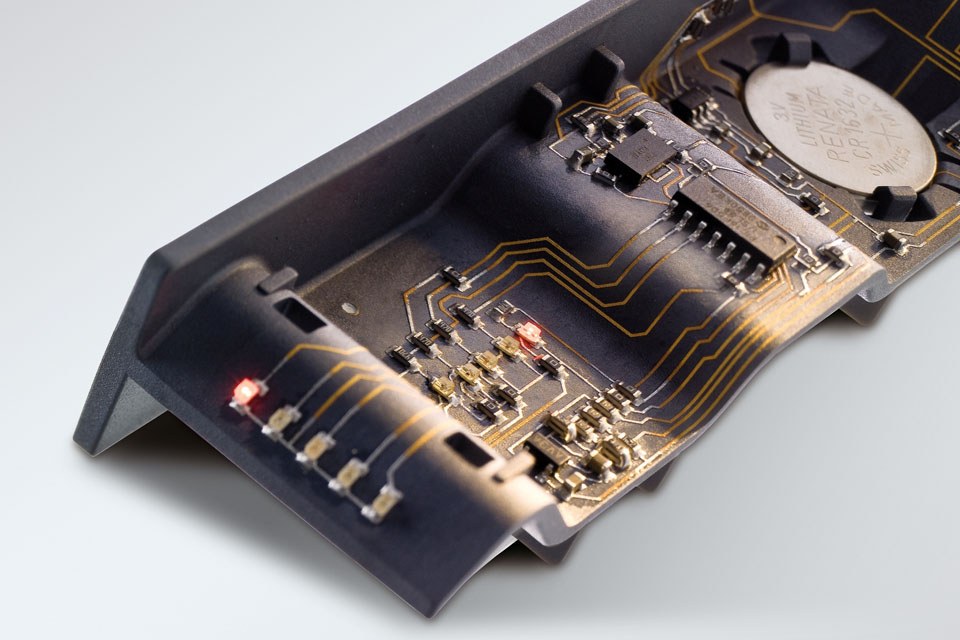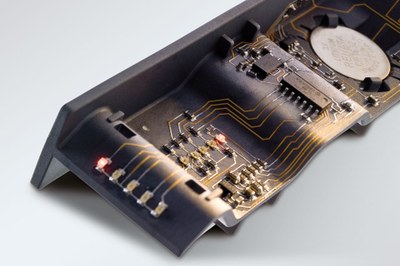Mounting LEDs in all Directions and Angles - Assembly Technology for LEDs on 3D-MID
Halogen lamps are very popular because of their warm light and the all-side light emission. Replacing halogen bulbs with LED lamps that have similar characteristics has not been satisfactory because LEDs mainly radiate in one direction. In order to replace a halogen bulb, LEDs must be mounted in different directions and angles. A technology that can provide this is the 3D MID (3-Dimensional Molded Interconnect Device). The combination of 3D-MID and LEDs is one of the most interesting future technologies for the lighting industry. A standard 3-D dispensing and placement machine now enables the cost-efficient, fully automatic assembly of such products.
Multi-Dimensional Radiation Without Lenses or Mirrors:
Today, 3D MIDs can be found in various industrial products. For example, some sensors, keys and switches for cars are using the technology. Other examples are found in medical instruments logistical devices or phones, where antennas, RFID transponders or illumination are part of the housing or packing.
For lamp manufacturers the 3D MID is an interesting alternative to traditional LED-assembly on PCB or aluminum substrates. It allows LEDs to be placed in any angle and direction. Therefore, radiation direction can be controlled without lenses or mirrors. Mounting LEDs into a cavity concentrates light; LEDs on a convex surface disperses light.
The 3D MID technology offers a great potential for savings, too, because it requires fewer production steps and uses less raw materials than traditional assembly technologies. However, until recently this potential was not used to a great extent for two reasons: First, flexible manufacturing of small series was difficult and second, the investment for special machines was high. In addition, 3D placement machines have not been designed for series production in an electronic production. This is now changing.
Laser Direct Structuring For Small Series:
There are three main processes known for 3D MID manufacturing: Hot Embossing, Two-Shot Molding and Laser Direct Structuring (LDS). In Two-Shot Molding, two types of plastics are injection molded of which one can be metal coated, the other one not. A metallization process then creates conductors directly on the plastic. For large series, this method can be economical, but for small series, investments are very high.
The Hot Embossing Technology uses a heated stamp to press a foil onto an isolated body and to cut out the conductors from the foil. This technology allows high conductor cross sections but needs expensive tooling. It also requires even surfaces and, therefore, is called a 2.5-D-Technology.
LDS, on the other hand, is very flexible because a laser creates the circuit on a molded piece. A doped plastic type is used, which is activated in some areas by a laser. The activated regions then can be metal coated, forming the circuit. To change a circuit layout, the laser can simply be reprogrammed.
Whatever technology is used to create the circuit, there is one more step to complete the 3D MID. SMD components and LEDs must be soldered and/or glued onto the circuit. The difficulty is that traditional dispensing and placement machines for electronics can only operate on a plain surface.
Dispensing and Placement from All sides:
Until recently, machines capable of SMD assembly for 3D MID have always been dedicated systems designed for large series production. However, for small series, a highly flexible standard 3-D machine is required. There have been several attempts to build such a 3D SMD placer.
Some manufacturers equipped a multi-axes robot with an SMD placement head. Many machine manufacturers have tried to convert a multi-axes robot into an SMD placement head. The substrate is held still and the robot dispenses and places in a half sphere radius to every position of the 3D MID. Unfortunately, this approach has some drawbacks. Gravity has a strong influence on the dispensing process as well as the placement process, making it difficult to guarantee quality assembly when the surfaces are not horizontal. Additionally, the operation and programming of a multi-axes robot is not common in traditional SMD production. Other manufacturers combined standard pick and place machines with special workpiece holders which is a solution with low flexibility and high costs.
Standard Pick and Place with 3D Substrate Holder:
Essemtec, the Swiss manufacturer of SMD production systems, now uses a different approach. Essemtec combines as standard 2-D pick-and-place machine with a special substrate holder that can be positioned in every angle. This design has many advantages.
One of the advantages is that operation and programming of the 3-D pick-and-place machine are similar to a standard machine. Also, the same component feeders, spare parts, vision system, pick-and-place tools and software can be used. Essemtec just expands the machine and control system and implements a special substrate holder that positions the 3D MID.
Regarding dispensing and placement process, this design also is advantageous. For both dispensing and placement, the machine can operate vertically, just like on standard dispensing and placement machines. Therefore, experience and parameters are directly exchangeable.
Designer Lamp in 3D MID Technology:
The company MID-TRONIC from Wiesau, Germany has developed a new type of designer lamp in 3D MID technology. LEDs are placed and soldered in different directions and angles. Accuracy is very important for this product because the LEDs must radiate in exactly calculated directions.
Available 3-D assembly machines could not satisfy the needs of MID-TRONIC. They were either not flexible or not accurate enough, or they were complicated in operation. Therefore, the company had contacted Essemtec to find a solution. In a strong collaboration with MID-TRONIC, Essemtec now converts a Paraquda SMD pick-and-place system into a standard 3D MID Placer.
The 3-D assembly machine will dispense solder paste and glue in any angle and will be able to place the LEDs with the required precision. The machine is designed for inline operation and will offer a performance of 3000 components per hour. In November 2011, the prototype will be exhibited at Productronica in Munich and then will be used by MID-TRONIC for 3D MID lamp manufacturing.
Essemtec will offer this machine as a standard 3D MID assembly platform that will allow 3-D assembly to be produced nearly as economically and simply as standard SMD assembly.
Marcel Freiermuth, Manager Solutions at Essemtec, will present on the topic “3-D LED Component Assembly Enables New Product Designs” on September 29 within the framework of the LED Professional Symposium.
Additionally, Essemtec AG will exhibit its fully automatic dispensing system CDS6200 with micro-dispensing valves at the LED Professional Symposium, taking place from September 27-29 in Bregenz. To meet with dispensing specialists or for a live demo, visit Essemtec in Foyer II on booth No. 14.
At both the LED Professional Symposium and LED Praxis Entwicklerforum, Essemtec will offer developers and users the ability to exchange information with its assembly professionals on-site. For free exhibitor passes to the Expo in Bregenz, contact mos@essemtec.com.
About Essemtec:
The Swiss machine manufacturer Essemtec is a market leader in manufacturing flexible production systems for industrial users. Essemtec has been developing, manufacturing and marketing equipment and machines for all processes in the electronics industry since 1991: printers, dispensers, pick-and-place and soldering systems. Manual, semiautomatic and fully automatic systems are available. The range of products also includes transportation and storage systems, as well as software solutions for planning, simulation optimization and documentation of manufacturing. All Essemtec systems are optimized for maximum flexibility. Users can switch from one product to another quickly, making maximum use of available production capacity. Essemtec - Be more flexible.


